|
Ampeer Paper Subscriber Reminder
When subscribing to or renewing the paper version of the Ampeer, please make the check payable to Ken Myers. We do not have a DBA for the Ampeer or EFO. Thanks, Ken
Porterfield Collegiate For Sale
Complete except for Speed control and receiver battery.
Includes Astro Flight 25G, 7ch Transmitter & receiver
Covered with Micafilm and finished with dope
Asking $100
Richard Fleming
408 Cottage St.
Olivet, MI 49076
269-749-9024
The Mid-Am 2008
On the weekend of July 11 - 13, the 2008 Mid-Am took place at its new location, the 7 Mile Road flying field of the Midwest R/C Society. The field was in excellent shape due to the hard work of several of the Midwest members. MWRCS member Jim Lapham was doing the final mowing and rolling of the field on Friday morning as the folks from "distant lands" started arriving. The runway grass was short and ready for all types of electrically powered aircraft.
Friday afternoon and evening proved to be the "best" day for flying.
Unfortunately, Mother Nature had some unpleasant surprises for the rest of the weekend. Saturday morning was cloudy and by about 11 o'clock the sky opened up for about an hour. Keith did get in his noontime demo, along with Laddie Mikulasko. The last All Up/Last Down in Mid-Am history was flown in a slight mist and overcast sky. It was arguably the best AULD in Mid-Am history which ended in an almost photo finish between Tim Young and Le Phan! Nice going guys!
By mid-afternoon, the sky cleared and good flying continued.
The annual steak sandwich/potluck pilot's picnic (Dave Hares head cook) was a HUGE success, and with the weather being almost perfect, there was a lot of flying after dinner until sunset.
Early Sunday morning, the wind was starting to pick up. By about 10:30 the winds had reached a constant 20 mph with gusts well over 30 mph. There was flying taking place, but the wind did take its toll on a few planes. Keith was able to do a demo about lunchtime, but only the brave and foolish ventured forth into the strong winds.
Even though my Son of Swallow was not flown on Sunday, it suffered damage, a crushed wing tip, when a heavy plastic lawn chair landed on it!
As usual, this was a party to celebrate electric flight with all of our new and "old time" friends. Despite the weather, the majority of the pilots said that they had a great time and planned on returning next year. They also had a lot of praise for the new flying site. Thanks Midwest!
As usual, awards were passed out to some of the most interesting planes and pilots!
Saturday's Awards
AULD - Le Phan (w/ Japanese co-pilot)
Best Scale - Miles & Atwood Special, Don Belfort
Most Beautiful - Thurston Teal, Laddie Mikulasko
Best Ducted Fan - Graupner Comet, David Damonio (Turbo)
Best Sport Plane - Tiger Kitten, Roger Wilfong
CD's Choice - F-14, Mark Wolf
Sunday's Awards
Best Scale - Zeppelin-Staaken XIV "R" bomber, Jim Beagle
Most Beautiful - Four Star Forty in red and white, Dennis Sumner
Best Mini-Electric - half-size Taurus, Paul Bradley
Best Multi-motor Ð QuadZilla, Mark Rittenger
CD's Choice - Super Quaker Bob Livin
We would like to thank Mark Lambert for heading up the Midwest concession stand (totally rearranging his personal work schedule) and his crew of MWRCS volunteers for allowing us to have a bite when we got hungry.
The Ann Arbor Falcons and EFO members really are the ones that put all the work into this meet, and Keith and I really appreciate everyone's help. A 'sincere thanks guys' to you all!
A Note from Pete Waters About the Mid-Am
Ken,
I just have to write to you and Keith concerning the annual event.
Over the years, I have occasionally popped in to see what was going on, and this year, in spite of the ailment; I was across the road several times.
The event is one that exemplifies the meaning of "fun fly" as intended. There was an atmosphere of enjoyment everywhere, and with the heavy rain and later on the winds, no one complained, but made the best of the occasion.
The relaxed attitude was everywhere, with no "halo" wearing by anyone.
I really enjoyed visiting, wished I could have helped more, and my grandson was also intrigued.
Jimmy Northmore was out for the first time, and also had a very pleasant time, as he is so conscious of his disability, and ended up meeting with Jack Lemon, and I had to drag him away!
So, big Cheers to you both and the organizers.
Very sincerely,
Peter Waters
Thanks Pete. Your comments mean a lot to both Keith and myself. We try very hard to keep this a "pilots' meet" and try to do everything we can to make our "guest pilots" feel comfortable and at home here.
Some of you may recognize Pete's name as he is a former District VII AMA VP, was on the frequency committee of the AMA for many years and was the owner/operator of Kraft Midwest for many years. The names of Jack Lemon and Jimmy Northmore may also sound familiar to some of you "old timers." Can you say Min-X radios? KM
Photos from the Mid-Am
From Keith McConnelly
Hi Ken,
I wanted to thank you for a wonderful time at the Mid-America Electric Flies 2008. The people I met were great and I truly enjoyed seeing the fabulous airplanes and autogyro flying. I can't believe the amount of energy you have to keep the event moving, launching airplanes and meeting with everyone.
I took some pictures of many of the planes flying. Unfortunately, I was a bad photographer and didn't get the names of either the pilots or models. I have posted then on the Internet and would be happy to share them with you, the readers of the "Ampeer", and other attendees at the Mid-America Electric
Flies 2008.
The URL is: http://gallery.me.com/kmcconnelly
Thanks again,
Keith
Thanks a lot Keith. Here are a few of your photos.
As far as the "energy" goes, well, as I recall, it was a lot easier at 42 than at 62, but Keith Shaw and I still love it all! :-)
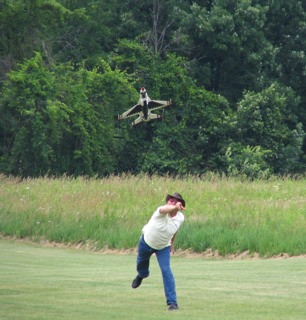
Ken Myers launches Dave McDonald's F-16
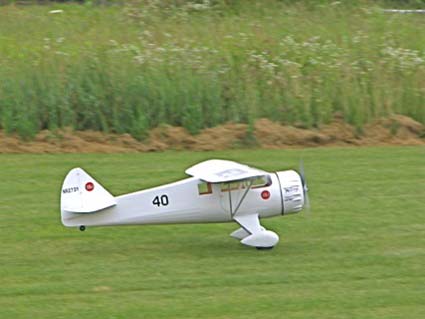
Jim Young's Mr. Mulligan
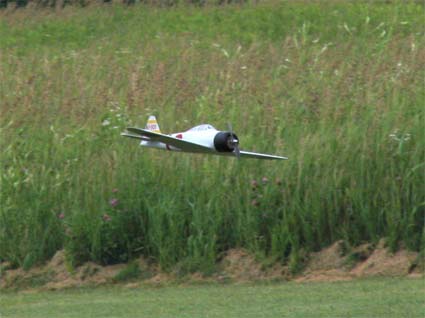
Jim Ryan's Zero
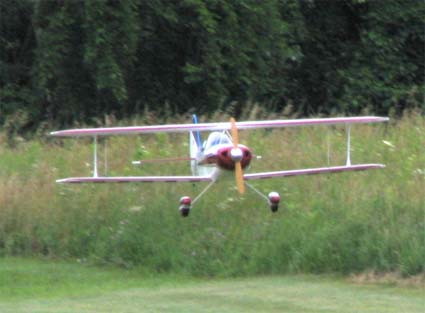
Jim Young's Super Skybolt
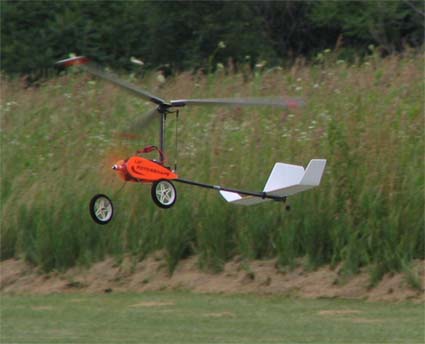
Dan Schwartz's Auto Gyro
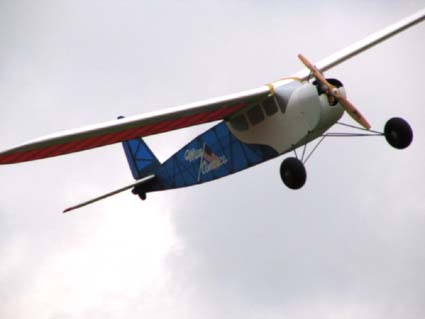
Bob Livin's Miss America
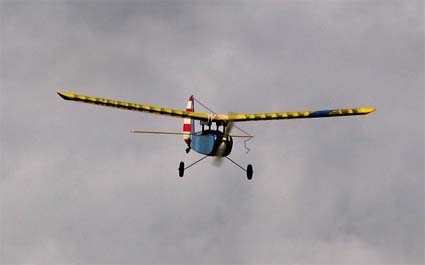
Roger Wilfong's Cutie
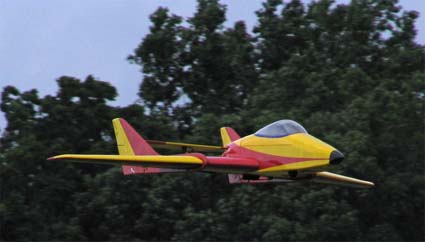
Turbo's Big, Impressive Pusher w/retracts
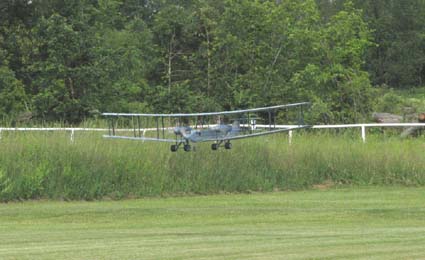
Zeppelin-Staaken XIV "R" bomber by Jim Beagle
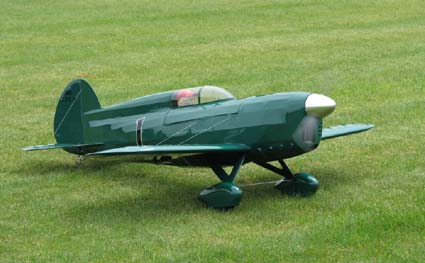
Mills & Atwood Special by Don Belfort
Mark Wolf took the two photos above of the bomber and MAS and they were posted on the RC Groups Web site. Mark has also posted a video of the bomber flying. The video can be found at:
www.rcgroups.com/forums/showthread.php?t=893306#post10138867
Paul Bradley posted the following photos to the RC Groups Web site.
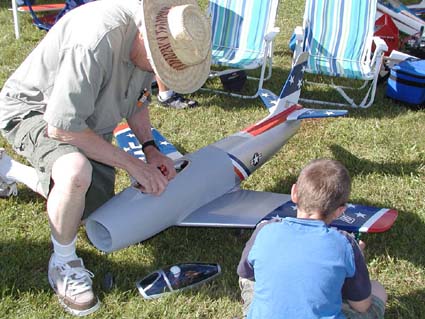
Tom's F-86
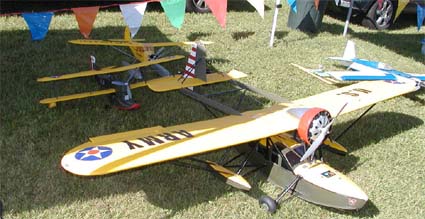
Al's seaplanes
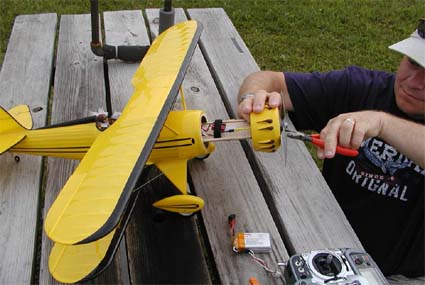
Jim Young working on his Waco YMF-5
A short kit is available at www.tnjmodels.rchomepage.com
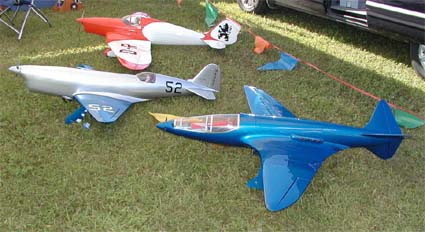
Keith's Stomo, Crosby CR-4 & Bugatti
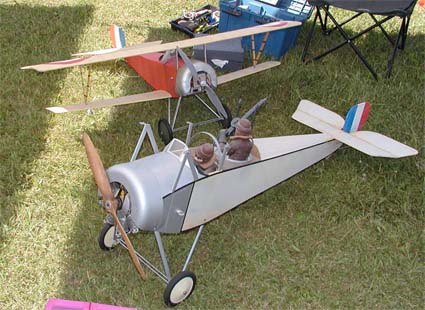
Martin's WWI Bipes
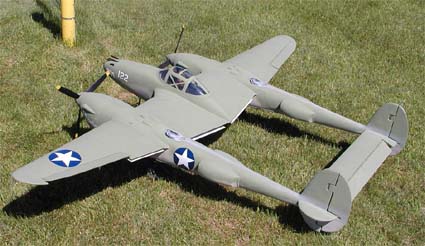
Tom's big P-38
More photos of the great planes that flew at the 2008 Mid-Am are available on the Web at:
www.rcgroups.com/forums/showthread.php?t=883862
The following photos are from the June 2008 The Peregrine's Post, the newsletter of the Ann Arbor Falcons, which is edited by Le Phan.

Keith (above/left) and Ken (below/center) brief the pilots at the pilots' meeting.

Return to "What's In This Issue"
Important Correction to:
The Node/Balance Connector Gotcha with the FMAdirect CellPro 10S
In the August 2008 Ampeer
In this article I originally stated:
"What bothered me most about all of this was that the complete first shipment, including the charger, USB cable and "PolyQuest" adapter, was sent for $8.95 and they charged $8.95 to send just the two CP10S-GP/KO6S adapters."
This was totally incorrect, and I apologize to FMAdirect for not checking my actual receipts and basing my comments on the Web order forms. The whole first shipment was made for $8.50, not $8.95. While the Web invoice indicated a shipping charge of $8.50, not $8.95, the actual invoiced shipping charge was a much more reasonable $3.00.
That also made point 3.) FMAdirect's one price shipping policy invalid as they DO NOT have a one price shipping policy.
I also want to make it absolutely clear that I have now had a chance to use the 10S with Li-Poly batteries and it is an EXCELLENT charger for them!
Return to "What's In This Issue"
An Indoor, Lightweight Grob 109
From Paulo Faustino chispas@sapo.pt
Hi, Ken.
Here is my latest, a rendition of a Grob 109.
This one has the horizontal stabilizer down on the fuselage at the base of the rudder to avoid fragilities and issues with the controls associated with T-tails.
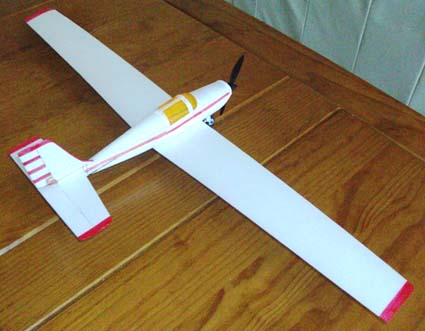
I used some pieces from the Cessna Minium, like the lower part of the fuselage that comes with the electronics, the electronics, gearbox, motor and propeller and the undercarriage.
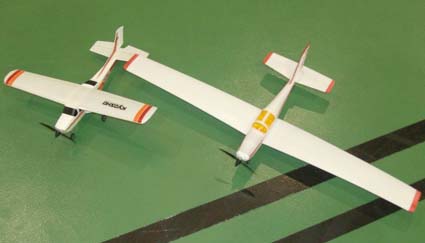
The wing needed some reinforcement with tape and 0.7mm carbon rod to prevent the wings from flexing too much:
br.youtube.com/watch?v=jiYtxsp7q4s
Now it weights 21,4g, 0,75 of an ounce. The wingspan is 70cm, 27.5", and if has a area of 4,25Dm2, 65 sq.in.
www.youtube.com/watch?v=qgmDsAUD6B4
Best regards.
Paulo Faustino, Portugal
Return to "What's In This Issue"
Indoor Flying "Up North" and More
From John Zook johnzook@voyager.net
Finally, an indoor flying site has been found for those in the Gaylord area. The ALPS club secured a site at the Alba High School gym. Many thanks go to Don Held and the guys at ALPS for their efforts in getting this site. Don is also the Associate V.P. for our area up here. So far those who wished to fly have been able to get in a couple Sunday mornings of indoor flying. A couple of the Charlevoix BUFFS also attended for what turned out to be a lot of fun for all who flew there.
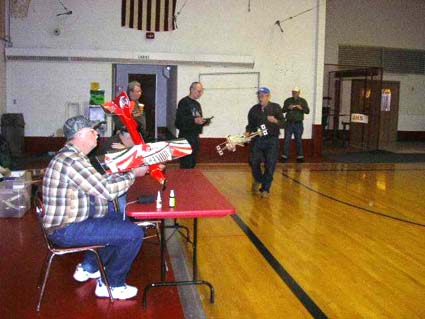
Indoor flying sites up here in Northern Michigan are limited to gymnasiums so sizewise it does prove to be a challenging and sometimes exciting endeavor.
All in all everybody has a good time and keeps those thumbs limbered for when the weather outside is more cooperative.
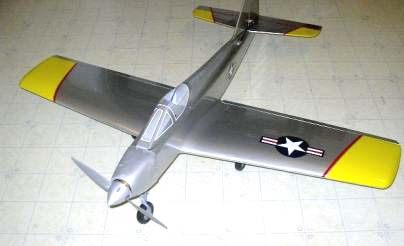
Here's my Sig Kougar finally finished. Initially I tested an AXI 2826-10 with an 11x7 prop and 5S 3700 Hyperion Li-Po pack, which proved to be too much for the motor, as I wanted to obtain around 850 to 900 watts for this plane.
After doing some research I came upon Hyperion motors available at AllERC - www.allerc.com. The Hyperion 4020-8 turn motor appears to provide enough power using an 11x7 prop with a 5S pack without strain. It is very well made and has great performance, as I now have three of the smaller versions, one in a Seniorita and one in an Ace 4-20. All E RC also provides plenty of information regarding specifications and performance values for most of their motors listed, which is a good assortment of sizes and performance. Once I obtain the motor I will post some performance details.
Well, it is not quite so finished as I now plan to repaint the cowl to match the yellow trim and some other trim details. No plane such as this would be complete without a pilot and finding one to fit was a bit of a snag but I finally found a source.
A final item: A close friend of mine attempted to fly his newly finished Great Plane E Seawind. The plane sadly made an unscheduled landing and was damaged somewhat. After inspection, it was found that the servo tray was not secured inside the fuselage. My friend is usually a careful builder and flyer, but just once he forgot an important step. Taking a few minutes to fully inspect a new model can mean all the difference between a successful first flight and disappointment. It seems that all too often in our excitement to see a new plane in the air, or even after its maiden, we take some things for granted and just assume all is well. So take a little time to make sure your plane is really ready for flight.
John Zook
Return to "What's In This Issue"
The RCM Funster ARF
From Rick Sawacki (EFO member) rrrjjjsss@aol.com

The plane has 72-inch wingspan with about 850 sq.in. of wing area and has a ready to fly weight of about 5 lbs. The flaps are for the "wow" affect, but with them down 10 degrees they will help for slow flight training. This plane will be used as a trainer for my students at the UFO (United Flying Organization) R/C field. I currently am training 3 students now with their electrics (store purchased ARFs and not the best) and wanted to have a better plane to show them what flying R/C is all about. All of my current planes are fully aerobatic, so I built this one. It should be about perfect for training the students and giving them a much better understanding of R/C flying.
Return to "What's In This Issue"
One Man's Junk is Another Man's Treasure
From Red Scholefield
I was discussing the K2 Energy cells via email with Bob Aberle, and Bob was sharing my information with Red. In a response back to Bob from Red he told of a recent experience at his flying field. I asked Red if I could share his experience with you, and he told me to go ahead and do it. So, here it is. KM
Great flying this morning. A couple of guys crashed and totaled,so they thought, their E-Flite Ultra STICK 25s. I took them from the trashcan to salvage some of the parts. I still can't understand why people throw these away without at least taking the horns, clevises, etc. But ARF flyers, I guess, have no use for them.
Anyway, when I got to looking them, a fuselage was broken in half, there was major damage forward of the leading edge, a was wing broken in middle and the wing tips crushed, they appeared repairable.
I had all the pieces, just like a kit. Now I have two great flying electrics.
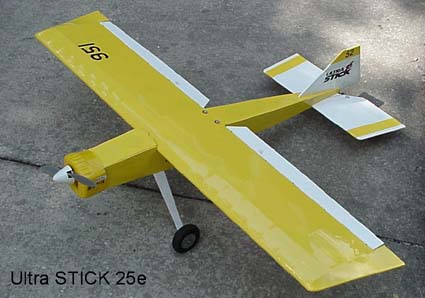
Note the cowling from a plastic bottle. I use an AXI 2820/14 with a 3S 4400 LiPo or 4S 2300 (A123).
And More...
Red followed up with some more information and these photos. KM
These photos show the work in process on the TWO Ultra Stick 25s that were both salvaged from the trashcan. I have the yellow one flying, and I have stashed the other one away. It is ready to cover.
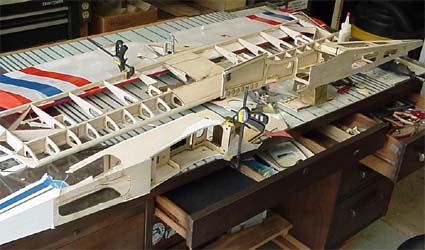
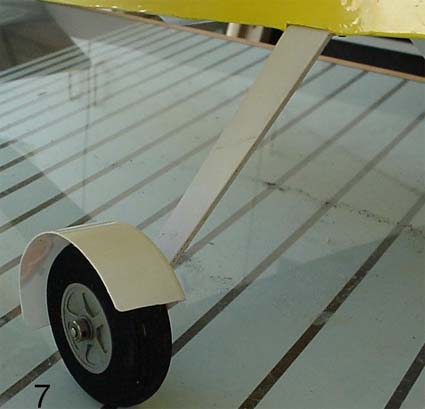
Note the wheel pants to keep fresh cut wet grass from accumulating on the aileron servos. This time of the year in Florida, our best flying is from sun up to about 10 a.m., so the dew is still on the grass.
The wheel pants are cut from a one-quart plastic ice cream container. Look for something that is about 1/2-inch greater in diameter than the wheels.
I found another one on e-Bay and I couldn't turn it down for $75. It was new in box from a hobby shop. They claimed it had covering defects. I cured the "defects" in about five minutes with a heat gun. Now I have two flying and one in reserve.
I really like these planes as they fit in the trunk of the Honda fully assembled. In addition, they are great flying models when using the AXI 2820/14 on 3S 4400mAh LiPo or 4S A123.
Take care,
Red S.
Thanks Red for sharing that with us all. While you've seen some of the following photos before of my Son of Swallow, I thought that I would run them again to encourage you to repair instead of replace. KM
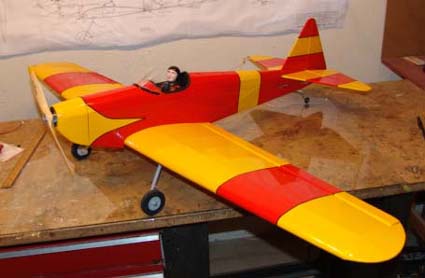
Version 1 - nearly finished with no "jugs" on cowl
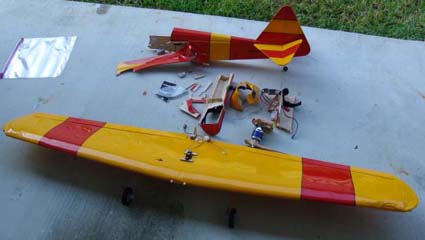
After maiden flight
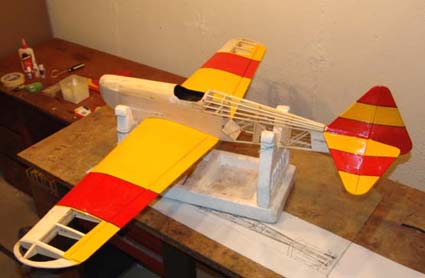
Partially rebuilt
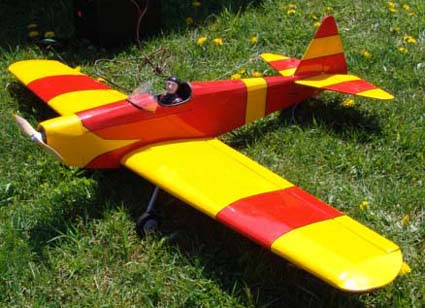
Ready for its "2nd" Maiden
The "jugs" were added later
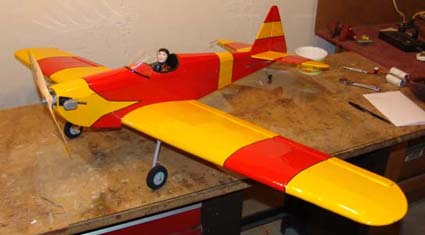
As I'm flying it today
Return to "What's In This Issue"
The FMAdirect CellPro 10S and Battery Resistance Readings
Everydayflyer (Charles) and I had noticed that we were getting quite different readings for the cell resistance for the 26650 K2 Energy cells that we've been testing. We weren't sure why.
There was recently a thread on RC Groups that might explain it.
www.rcgroups.com/forums/showpost.php?p=10301473&postcount=124
The post is by Howard Matos of FMAdirect and partially reads, "Here is what is happening, higher voltage is making higher current. The higher current is making higher mOhm. This is what you are seeing. The mOhm reading is designed to be accurate at a 1C charge rate in the manual mode. Set the charge current to a manual 1C rate. By making a constant current, it will make a constant mOhm."
If you are going to use your CP-10S for mOhm readings and compare them to others, please be sure to follow Howard's advice. This is NOT documented in the manual at this time.
Return to "What's In This Issue"
A Lazy Bee Takes Flight
From Jim Yuzwalk jjy@pop4.net
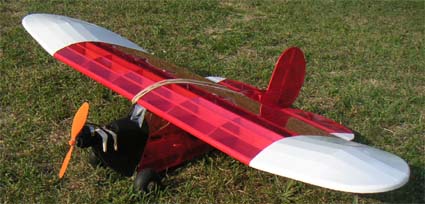
Hi Ken,
I thought I'd forward you a few photos of my recently completed Lazy Bee. You probably haven't seen one of these for a long time. I began this project back in 1994. I just completed it this July 2008. A newborn baby boy in April 1995 and graduate school in 2004 temporarily put the Lazy Bee project on hold.
A couple of the pictures show my two sons, Troy and Tyler, happily posing with the Lazy Bee. The boys kept asking me when I would finish building the Bee. So, during summer break, I decided to give it a whirl.
It felt great to work on a balsa plane again. I mostly work with foam models now-a-days, so working with balsa and light plywood brought back some fond memories. I had to rework the plans a bit to accommodate an UltraFly brushless upgrade kit using a ThunderPower 11.1 V LiPoly. The main modifications being the motor mounting technique and the battery compartment structure.
Back in 1994 I had planned to use a geared speed 400 motor with a homemade 7 cell battery pack using Sanyo N-14000SCR NiCad cells weighing in at 14.2 oz. The ThunderPower pack only weighs 4.6 oz. And, by judiciously placing the motor and Li-Poly battery way up front, the Lazy Bee balanced perfectly with no need for additional weight.
Flying the Lazy Bee takes a bit of getting used to, it just floats along. Take offs and landings are a piece of cake. About the only troublesome spot is during turns. Sometimes a turn can quickly become a spiral if you're not careful. Nevertheless, it's a lot of fun to see and fly. I'm planning to give the boys a few flying lessons using the Bee -- their first lessons were on an EZ-Star that I built for them as per your recommendation through the Ampeer newsletter.
And in a follow-up Email
I was pretty tired after work on Thursday, so after dinner I took a late nap. I got up around 8:30 PM and noticed that the air outside was dead calm, so I broke out the Lazy Bee. Tyler, my youngest, and his friend Devon stopped bouncing on the trampoline to watch me fly the Bee. After a few adjustments, including lots of right turn input, the Lazy Bee actually flew fantastically! Slow flight, and I mean extremely slow flight, is where the Bee really shines. It flew straight and level hands off and at a crawl. I did many slow fly buys at low altitude and even a bunch of touch and goes. The boys were geeked. They could actually out run the Lazy Bee. They had a blast chasing the plane. We all had a great time. Truly a memorable and joy filled experience.
The boys will definitely be flying the Bee in the near future. It has all of the characteristics of a great trainer: slow and forgiving flight, gentle recovery, and straight and level hands off flight. I'd even go as far as to say it beats the EZ-Star, except, possibly, that it's built up balsa construction -- i.e., harder to build and probably more damage prone.
By the way, I was getting better than half hour flight times using the 2,000 mAh ThunderPower battery pack. Not really too surprising considering the Bee was literally just floating along.
My only modification to the UltraFly upgrade kit was using a 9x7 GWS prop -- it pulls about 12 Amps at full throttle, more than enough power for the Lazy Bee. The GWS props are good performers, and they are inexpensive -- they come in packs of six. I have used the UltraFly upgrade kits on my small fleet of GWS planes: F4U Corsair, Spitfire, and P-51 Mustang. The up-grade kit includes a brushless motor, prop, and gearbox. It's a nice inexpensive performer that mates well with many park flyers. I first came across the upgrade kit on the UltraFly SU-27. The SU-27 is a handful compared to the Lazy Bee.
Best regards,
Jim Yuzwalk
Return to "What's In This Issue"
|

































